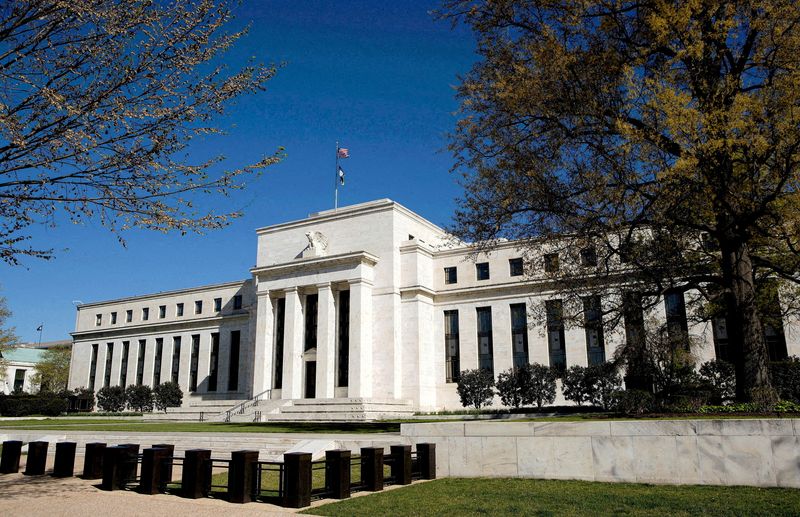Fed is aligned on rate cuts, but upcoming data will shape the pace
2024.09.27 07:19
By Howard Schneider
WASHINGTON (Reuters) – The Federal Reserve did not have full consensus when it voted last week to reduce interest rates by half of a percentage point, with one policymaker dissenting and economic projections implying others were at least a bit reluctant to start the easing cycle with an outsized move.
New inflation data on Friday may help clarify whether the U.S. central bank is heading towards another large rate cut, as many investors expect, or a smaller one. But as the Sept. 17-18 policy meeting demonstrated, Fed officials with the same data in hand can draw different conclusions depending on what they find more important, what timeline they emphasize, and what risks they care most about.
Fed officials’ public comments since last week’s policy decision show the different points of emphasis that have emerged and some fault lines that may get attention between now and the Nov. 6-7 policy meeting.
LABOR MARKET IS ‘JOB ONE’
Jobs data will be key. Fed Chair Jerome Powell has made defending low unemployment a chief aim of his tenure. He’s concerned risks to the job market are increasing. Evidence of that in coming labor market reports, including the September jobs report due on Oct. 4, would argue for larger or faster rate cuts.
“There are many, many employment indicators and what do they say? They say this is still a solid labor market,” Powell said at his post-meeting press conference on Sept. 18, noting the current 4.2% unemployment rate is below the long-run U.S. average.
But the trajectory of several aspects of the job market “bears close watching,” he said. “A broad set of indicators suggests that conditions in the labor market are now less tight than just before the pandemic,” an era Powell regards as a sweet spot with sustained low unemployment and wages rising at a solid, non-inflationary pace.
The unemployment rate, for example, has been rising, and policymakers expect it to end 2024 at 4.4%, a full percentage point above the lows in 2023 and a higher level than what Powell inherited when he became Fed chief in early 2018.
Notably, the closely watched relationship between job openings and unemployment now shows the labor market loosening through a decline in openings rather than outright job losses. Powell said the U.S. is “very close to that point, if not at it,” where “further declines in job openings will translate more directly into unemployment.”
INFLATION MAY BE TOO LOW
The Fed was vexed for roughly a decade after the 2007-2009 financial crisis by inflation that was stuck below its 2% target despite years of loose monetary policy.
Why worry about it? While some would argue 0% inflation would best meet the Fed’s mandate for “stable prices,” central bankers around the world believe some modest inflation keeps firms and consumers looking forward, giving a built-in incentive to spend, invest and hire rather than sitting on the sidelines hoping prices or wages will fall, a recipe for a corrosive spiral of deflation.
In a surprising shift of emphasis, Fed Governor Christopher Waller, a key voice in the central bank’s two-year inflation battle, noted last week that over a three- or four-month time frame inflation was now running below target and could slip even lower if shelter cost increases slow as anticipated.
“That is what put me back a bit to say, ‘wow, inflation is softening much faster than I thought it was going to,'” Waller said on CNBC, adding that this realization put him “over the edge” into backing the half-percentage-point cut last week.
The release on Friday of the personal consumption expenditures price index for August will show if Waller’s assessment is correct. Whatever the data, his comments show how shorter-term estimates of inflation – rather than the year-over-year data used to set the Fed’s target – are figuring into the debate.
BREADTH OF INFLATION NARROWS
Atlanta Fed President Raphael Bostic, among others, had often cited the breadth of inflation throughout the economy as a key argument for caution about cutting rates too soon.
That concern has essentially evaporated. Monthly headline inflation has become increasingly concentrated in housing, prompting Bostic to support a rate cut last week that he previously didn’t anticipate would be warranted until later in the year.
“The breadth of price increases is narrowing to a range that accords with price stability,” Bostic said after the Sept. 17-18 meeting. The share of items increasing at 5% or more in July was only 18%, the lowest since 2020 and comparable to the long-term average of 17%.
Housing is now “one of the only areas of residual elevated price pressures,” he said.
HAWK’S EYE VIEW
As a generally risk-averse bunch, no one at the Fed is eager to declare victory over inflation, which given the events of recent years is considered a surefire way to tempt fate.
Most notably, Fed Governor Michelle Bowman, in dissenting against the half-percentage-point cut in favor of a quarter-percentage-point reduction, kept her logic simple: Inflation is still too high, and cutting rates now could rekindle demand and spending before price pressures have been truly squelched.

Using the same data as Waller and others, she interpreted it through a different lens where inflation risks still lurked and kept her focus on the year-over-year rate used to set the Fed’s target, not the shorter-term calculations Waller emphasized.
“The U.S. economy remains strong and core inflation remains uncomfortably above our 2% target,” Bowman said. “Bringing the policy rate down too quickly carries the risk of unleashing … pent-up demand. A more measured approach would also avoid unnecessarily stoking demand and potentially reigniting inflationary pressures.”








